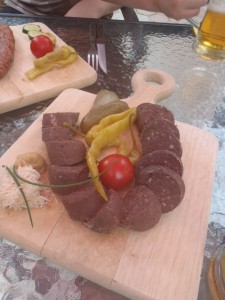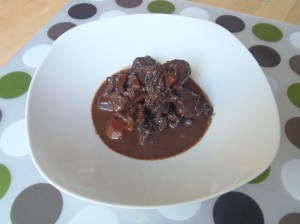 When I first had Blunz’n at a tavern in Austria I had a very narrow idea of what blood sausage was. Most of the blood sausage I had eaten before this moment I had made myself, following recipes in Ruhlman’s Charcuterie and the Au Pied de Cochon cookbook. These versions are simply pork blood studded with cubes of pork fat and onion. The Austrian Blunz’n before me was radically different: it was soft and moist, but closer in texture to a dumpling then boudin noir, and it was burgundy, not black.
When I first had Blunz’n at a tavern in Austria I had a very narrow idea of what blood sausage was. Most of the blood sausage I had eaten before this moment I had made myself, following recipes in Ruhlman’s Charcuterie and the Au Pied de Cochon cookbook. These versions are simply pork blood studded with cubes of pork fat and onion. The Austrian Blunz’n before me was radically different: it was soft and moist, but closer in texture to a dumpling then boudin noir, and it was burgundy, not black.
Before I left Austria I got a Blunz’n recipe from one of my chaperones. I read through the recipe and thought there must have been some kind of … Continue reading.
Heurigen (“HOY-ree-gen,” singular heuriger) are special taverns in Austria that serve young wine or cider, depending on the region.
The word heuriger literally means something like “of the current year”. So for instance new potatoes are called heurige erdäpfel. With regards to wine it refers to wine from the last vintage, ie. wine that has not been bottled or aged. Heuriger taverns open up for a couple of weeks at a time so that guests can drink young wine and eat plates of cold food such as cheese, spreads, bread, and charcuterie. The word for these savoury accompaniments is brettljause (“BRET-tel YOW-ze”). Brett means board, as the food is usually spread out on a wooden board. Brettl, … Continue reading.
This blood terrine is based on a recipe from Fergus Henderson’s book The Whole Beast. The procedure and recipe are almost identical to those for blood sausage:
- sweat onions, garlic, and spices in butter;
- add blood and heat to thicken;
- add cornmeal in a steady stream, stirring constantly to prevent clumping;
- heat the mixture until it thickens;
- add diced backfat;
the only difference being that the mixture is cooked in a loaf pan in a water bath instead of casings.
This cake set beautifully. It was tender, but held up to slicing. This experiment reinforces my theory that there was too much moisture in the other blood sausages. (The cornmeal in the cake was cooked directly in the blood, … Continue reading.
Blood sausage is, as I have written before, pretty much what you would expect: pig’s blood and fat, seasoned and stuffed into casings. The sausages are almost always flavoured with onions, and often contain a starch like oats or cornmeal or rice.
I have only come across blood sausage twice in Edmonton. My first taste was at Charcutaria Micaelense on 118 Avenue, but they have since stopped making their own and instead carry an inferior commercial substitute. More recently I have tried the blood sausage at Old Country Meats.
There are a few reasons we don’t see it very often here. First: our timorous approach to eating. Second (and closely related to the first…): the hassle of obtaining pig’s … Continue reading.
 This week I had the opportunity to cook with pig’s blood. There’s actually more classical applications for blood than you may think.
This week I had the opportunity to cook with pig’s blood. There’s actually more classical applications for blood than you may think.
Fresh blood has a beautiful colour, similar to red wine, but with an opalescent sheen. When heated, the blood turns burgundy, then brown, and eventually black. It coagulates somewhere around 75°C, which makes it ideal for thickening liquids.
Civet: A Gateway Dish
If you’re at all squeamish about cooking with blood, this is probably a good dish to start with.
The two things that make a civet a civet are: one, that game is marinated in wine which is later used to braise the meat; and two, that the braising liquid is thickened with blood and used as … Continue reading.
The personal website of Edmonton chef Allan Suddaby
 When I first had Blunz’n at a tavern in Austria I had a very narrow idea of what blood sausage was. Most of the blood sausage I had eaten before this moment I had made myself, following recipes in Ruhlman’s Charcuterie and the Au Pied de Cochon cookbook. These versions are simply pork blood studded with cubes of pork fat and onion. The Austrian Blunz’n before me was radically different: it was soft and moist, but closer in texture to a dumpling then boudin noir, and it was burgundy, not black.
When I first had Blunz’n at a tavern in Austria I had a very narrow idea of what blood sausage was. Most of the blood sausage I had eaten before this moment I had made myself, following recipes in Ruhlman’s Charcuterie and the Au Pied de Cochon cookbook. These versions are simply pork blood studded with cubes of pork fat and onion. The Austrian Blunz’n before me was radically different: it was soft and moist, but closer in texture to a dumpling then boudin noir, and it was burgundy, not black.